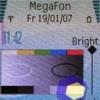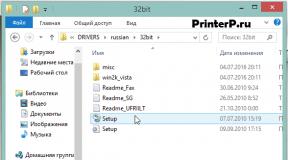Homemade infrared soldering station. Do-it-yourself budget laptop repair
Sooner or later, a radio mechanic involved in the repair of modern electronic equipment is faced with the question of purchasing an infrared soldering station. The need has arisen due to the fact that modern elements are massively “throwing their hooves away”; in short, manufacturers of both small and large integrated circuits are abandoning flexible leads in favor of patches. This process has been going on for quite some time.
Such chip packages are called BGA - Ball grid array, in other words - an array of balls. Such microcircuits are mounted and dismantled using a non-contact soldering method.
Previously, for not very large microcircuits it was possible to get by with a hot-air soldering station. But large GPU graphics controllers cannot be removed and installed with a thermal air blower. Maybe just warm it up, but warming it up doesn’t give long-term results.
In general, closer to the topic.. Ready-made professional infrared stations have exorbitant prices, and inexpensive 1000 - 2000 green ones do not have enough functionality, in short, you still have to add them. Personally, for me, an infrared soldering station is a tool that you can assemble yourself and to suit your needs. Yes, I don’t argue, there are time costs. But if you approach the assembly of the IR station methodically, you will get the desired result and creative satisfaction. So, I have planned for myself that I will work with boards measuring 250x250 mm. For soldering TV Main and computer video adapters, possibly tablet PCs.
So, I started with a blank slate and a door from an old mezzanine, screwing 4 legs from an ancient typewriter to this future base.

Using approximate calculations, the base turned out to be 400x390 mm. Next, it was necessary to roughly calculate the layout based on the sizes of the heaters and PID controllers. Using this simple “felt-tip pen” method, I determined the height of my future infrared soldering station and the bevel angle of the front panel:

Next, let's take on the skeleton. Everything is simple here - we bend the aluminum corners according to the design of our future soldering station, secure it, and tie it together. We go to the garage and bury our heads in DVD and VCR cases. I do a good job of not throwing it away - I know it will come in handy. Look, I’ll build a house out of them :) Look, they build from beer cans, from corks, and even from ice cream sticks!
In short, you can’t imagine a better cladding than equipment covers. Sheet metal is not cheap.

We run to the shops in search of a non-stick baking sheet. The baking tray must be selected according to the size of the IR emitters and their number. I went shopping with a small tape measure and measured the sides of the bottom and the depth. To questions from sellers like: “Why do you need pies of strictly specified sizes?” He answered that the inappropriate size of the pie violates the overall harmony of perception, which does not correspond to my moral and ethical principles.

Hurray! The first parcel, and it contains especially important spare parts: PIDs (what a scary word) The decoding is also not simple: Proportional-Integral-Differential controller. In general, let’s understand their setup and operation.

Next is the tin. This is where we had to work hard with the DVD covers so that everything would turn out smoothly and solidly, we’re doing it for ourselves. After adjusting all the walls, you need to cut the necessary holes for the FIDs on the front wall, for the cooler on the back wall and for painting - in the garage. As a result, the intermediate version of our IR soldering station began to look like this:

After testing the REX C-100 regulator designed for preheating (bottom heater), it turned out that it is not entirely suitable for my soldering station design, because it is not designed to work with solid-state relays, which it is supposed to control. I had to modify it to fit my concept.

Hurray! A parcel has arrived from China. Now it already contained the most basic wealth for building our infrared soldering station. Namely, these are 3 lower IR emitters 60x240 mm, the top 80x80 mm. and a pair of 40A solid-state relays. It was possible to take 25 amps, but I always try to do everything with a reserve, and the price was not much different..

The eyes are afraid, but the hands are doing. I try not to forget this old truth, just like about chicken, one grain at a time... What we have in the end - After installing the emitters in a baking tray, installing the solids on the radiator, blown by the cooler and connecting everything, we got something more or less similar to infrared soldering station.

Once the preheating thing started to come to an end and the first tests on heating, temperature retention and hysteresis were done, we could safely move on to the upper infrared emitter. It turned out to be more work than I initially expected. Several design solutions were considered, but in practice the last option turned out to be more successful, which I implemented.

Making a table to hold the board is another task that requires heating the skull. It is necessary that several conditions be met - uniform holding of the printed circuit board so that the board does not sag when heated. In addition, it was possible to move an already clamped board left or right. The board clamp should be both strong and give a little slack, since the board expands when heated. Well, the table should also have the ability to secure boards of different sizes. Not yet fully finished table: (no clothespins for the board)

Now the time has come for testing, debugging, adjusting thermal profiles for different types of microcircuits and solder alloys. During the fall of 2014, a decent number of computer video cards and television Main-boards were restored

Despite the fact that the soldering station seems complete and has proven itself to be excellent, in fact, several more important things are missing: Firstly, a lamp, or a flashlight on a flexible leg, Secondly, blowing the board after soldering, Thirdly, I initially wanted to make a selector for the lower heaters..
Of course, I didn’t write everything I wanted, because during assembly there were a lot of little things, problems and dead ends. But I recorded the entire construction process on video and now this is a full-fledged training video course:

Show phone
A network of service centers in Nizhny Tagil provides services for repairing household appliances at home on the same day of call. Fast. Qualitatively. Inexpensive.
The highly qualified and extensive experience of our technicians allows us to eliminate the most complex faults.
The technician conducts diagnostics, identifies the breakdown, decides on the necessary restoration work, and names the price. Diagnostic services and a technician's visit will be free if you agree to the repair.
Our service provides repair services for household appliances:
Refrigerator repair
The most common malfunctions of refrigeration equipment are freezers. Deviations in operation cause disruption of the cooling cycle, the appearance of a puddle in the inside of the chamber, and the lighting turns off. Pipelines, shock absorbers, doors, hinges, door handles are adjusted, brackets and power cords are replaced.
Repair of washing machines
Washing machines contain electronic boards and hydraulic automation devices. Only a specialist can carry out diagnostics and repairs.
Call now
Electric stove repair!
Such household appliances contain heating elements and electronic circuits. Failure to do so may result in fire and electric shock. If slabs break, it is recommended to use the services of a specialized company.
Dishwasher repair
Is your dishwasher broken and you have to wash your dishes by hand? We will restore the functionality of household appliances, saving you from a grueling and monotonous task. We provide repair services for dishwashers of all brands, eliminating faults of any complexity. To restore equipment, only original spare parts are used, and all types of work are guaranteed for up to 24 months.
Call now!
Repair of microwave ovens (microwave ovens)
The microwave oven cannot be connected if it does not turn on. An electrical appliance can become unusable for three main reasons:
1. Fuses have blown.
2. Faulty magnetron.
3. The mica plate has burnt out and needs to be replaced immediately.
Call now!
Water heater repair
Attention! Water heaters contain electronic boards, hydraulic automation and other complex components. Trying to repair the device yourself may lead to even more serious problems.
TV repair
A network of service centers offers in-home repairs of all models of LCD TVs. Due to the presence of qualified craftsmen, all the necessary diagnostic equipment, tools, original spare parts, we carry out work quickly and efficiently.
Computer Repair
We issue a guarantee of up to 24 months for all installed components and services performed.
Bottom heating, also known as an infrared heater, is used for uniform heating during dismantling and installation of BGA components and microcircuits.
Why do you need bottom heating?
In the picture below we see a BGA chip that is located on a printed circuit board. If you blow hot air onto a microcircuit, then the microcircuit will only warm up from above. The solder balls and PCB will be cooler than the chip itself. As a result, the microcircuit may overheat and fail.
The situation changes dramatically for the better if you heat the board with the microcircuit not only from above, but also from below using bottom heating.

In this case, both the board and the microcircuit will warm up from all sides: both below and above. The solder balls and PCB will already be hot, as will the chip. As a result of this, the solder balls on both the bottom and top will melt at the same time, which reduces the risk of tearing off the printed conductors on the PCB itself.
There is also a second advantage of bottom heating. When we heat it with a hairdryer without bottom heating, the board gets very hot in some places, but not in others. Due to the expansion of the substance under the influence of temperature, in places where we fry with a hairdryer, the board will expand and can lead to dire consequences. It will swell and break the connections between the layers, since the boards of mobile phones and computers are made multilayer. With the help of bottom heating, the board is heated evenly over the entire area, therefore, sad consequences can be avoided.
How to work with bottom heating
My bottom heater looks like this
Here we have four clamping bolts with which our patient is clamped
Basically, I set the temperature on my bottom heating platform to 200 degrees. To do this I press the button
and turn the wheel
We fix the patient and wait five minutes. When our board warms up, we begin dismantling the SMD component.
Where to buy bottom heating
On Ali, where else)

You can look them up at this link.
But it’s better to take a closer look at soldering platforms that combine not only bottom heating, but also a soldering iron and a hair dryer in one set. Such a soldering platform will be even more convenient than buying everything separately

Digital heating systems "TERMOPRO" are designed for uniform and gentle heating of printed circuit boards during repair and production. They can also be used for reflow soldering of solder paste along a thermal profile in small-scale or single production of printed circuit assemblies.
Areas of use:
- heating of printed circuit boards when soldering BGAs as part of an infrared soldering station;
- preheating of printed circuit boards when soldering SMD;
- preheating during repair of printed circuit boards;
- heating ceramic components before soldering;
- heat curing of glue;
- preheating of silicon wafers;
- preheating of boards on radiators.
Advantages:
- Uniform heating. The TERMOPRO board heater allows for uniform and gentle heating, thereby minimizing the likelihood of damage to components. Since printed circuit board elements are extremely susceptible to temperature changes, this avoids the significant cost of rebuilding or replacing them.
- Versatility. The TERMOPRO board heater is suitable for working with almost any printed circuit boards up to 400 mm wide. This allows you to perform a wide range of tasks without the need to purchase additional equipment.
- To heat the board, you can fix it in a special holder and select the optimal mounting points. This also allows for bottom heating of the boards at the required height from the heater surface.
Still have questions?
An infrared soldering station is a device for soldering microcircuits in a BGA package. If what you read doesn’t tell you anything, you probably shouldn’t go to the cat. There are arduinos, graphs, programming, ammeters, screws and blue electrical tape.
First background.
My professional activity is in some way connected with electronics. Therefore, relatives and friends constantly strive to bring me some electronic device that is not quite working properly with the words “well, look, maybe some wiring has come unsoldered.”
At that time, such a thing turned out to be a 17" eMachines G630 laptop. When you pressed the power button, the indicator came on, the fan made noise, but the display was lifeless, there were no beeps and no hard drive activity. An autopsy showed that the laptop was built on the AMD platform, and the north bridge is marked 216-0752001. A quick Google showed that the chip has a very bad reputation in terms of reliability, but problems with it are easily diagnosed. You just need to warm it up. I set the soldering gun to 400 degrees and blew on the chip for 20 seconds. The laptop started up and showed the picture .
The diagnosis has been made. It would seem that it’s a small matter - re-soldering the chip. This is where the first revelation awaited me. After calling service centers, it turned out that the minimum amount for which you can change a chip in Minsk is $80. $40 for the chip and $40 for the labor. For a laptop with a total cost of $150, it was not very budget-friendly. A friendly introduction service offered to resolder the chip at cost - for $20. The final price tag dropped to $60. The upper limit of a psychologically acceptable price. The chip was successfully soldered, the laptop was assembled, given away, and I happily forgot about it.
The second background.
A few months after the end of the first backstory, a relative called me and said, “You love all kinds of electronics. Pick up your laptop for spare parts. For free. Or I'll just throw it in the trash. They said it looked like a motherboard. Chip dump. It is not economically feasible to repair.” So I became the owner of a Lenovo G555 laptop without a hard drive, but with everything else, including a power supply. Turning it on showed the same symptoms as in the first prehistory: the cooler is spinning, the lights are on, there are no more signs of life. The autopsy showed an old friend 216-0752001 with traces of manipulation.

After warming up the chip, the laptop started up as if nothing had happened, as in the first case.
Reflections.
So I found myself the owner of a laptop with a faulty north bridge. Should I take it apart for parts or try to repair it? If the latter, then solder it on the side again, even for 60 dollars, and not 80? Or buy your own infrared soldering station? Or maybe assemble it yourself? Do I have enough strength and knowledge?
After some thought, it was decided to try to fix it, and to fix it myself. Even if the attempt is unsuccessful, it won’t hurt to disassemble it for parts. And the infrared station will be a useful aid in many works that require preheating.
Technical task.
Having studied the prices for ready-made industrial infrared stations (from $1000 to plus infinity), sifted through a bunch of topics on specialized forums and videos on Youtube, I finally formed the technical specifications:
1. I will make my own soldering station.
2. The design budget is no more than $80 (two solderings at the service center without materials).
Additionally, the following were purchased offline:
Linear halogen lamps R7S J254 1500W - 9 pcs.

Linear halogen lamps R7S J118 500W - 3 pcs.

R7S cartridges - 12 pcs.

The following were pulled out of the trash in the garage:
Docking station from some antediluvian Compaq laptop - 1 pc.

Tripod from a Soviet photo enlarger - 1 pc.

Power and signal wires, an Arduino Nano, and WAGO terminal blocks were found in a home storage room.
Bottom heater.
We arm ourselves with a grinder and cut off everything unnecessary from the docking station.

We attach cartridges to a sheet of metal.

We connect three cartridges in series, resulting in three chains in parallel. We install the lamps and hide them in the housing.

The search for material for the reflector took a long time. I didn't want to use foil because I suspected it wouldn't last long. It was not possible to use thicker sheet metal due to difficulties in processing it. A survey of familiar employees of industrial enterprises and a visit to non-ferrous metal purchase points did not yield any results.
In the end, I was able to find sheet aluminum that was slightly thicker than foil, which was ideal for me.

Now I know exactly where to look for such sheets - from printers. They attach them to the drums in their cars, either to transfer paint, or for something else. If anyone knows, tell me in the comments.
Bottom heater with installed reflector and grille. Instead of a grille, it is more correct to use, but it is not at all budget-friendly, like everything with the “Professional” sticker.

Shines a beautiful orange light. It doesn’t burn your eyes, you can look at the light completely calmly.

Consumes about 2.3 kW.

Upper heater
The design idea is the same. The cartridges are screwed with self-tapping screws to the cover of the computer power supply. A reflector bent from an aluminum sheet is attached to it. Three five hundred watt halogens are connected in series.

It also glows orange.

Consumes about 250 watts.

Control circuit
An infrared station is an automatic machine with two sensors (board thermocouple and chip thermocouple) and two actuators (lower heater relay and upper heater relay).

It was decided that all the heating power control logic would be implemented on a PC. Arduino will only be a bridge between the station and the PC. I received the parameters for PWM control of the heaters from the PC - set them - sent the temperature of the thermocouples to the PC, and so on in a circle.
Arduino expects messages like SETxxx*yyy* on the serial port, where xxx is the power of the upper heater in percent, yyy is the power of the lower heater in percent. If the received message matches the template, the PWM coefficients for the heaters are set and the OKaaabbbcccddd message is returned, where aaa and bbb are the installed power of the upper and lower heaters, ccc and ddd are the temperature received from the upper and lower thermocouples.
A “real” hardware PWM microcontroller with a sampling frequency of several kilohertz is not applicable in our case, since a solid-state relay cannot turn off at an arbitrary point in time, but only when the alternating voltage passes through 0. It was decided to implement our own PWM algorithm with a frequency of about 5 hertz. At the same time, the lamps do not have time to go out completely, although they flicker noticeably. In this case, the minimum duty cycle, at which there is still a chance to capture one period of the mains voltage, turns out to be 10%, which is quite enough.
When writing the sketch, the task was to refuse to set delays using the delay() function, since there is a suspicion that at the moment of delays, data from the serial port may be lost. The algorithm turned out to be as follows: in an endless loop, the presence of data from the serial port and the value of the software PWM time counters are checked. If there is data from the serial port, we process it; if the time counter has reached the PWM switching values, we carry out actions to turn the heaters on and off.
#include
Application for computer.
Written in Object Pascal in the Delphi environment. It displays the state of the heaters, draws a temperature graph and has a built-in primitive modeling language, more reminiscent of some Verilog in philosophy than, for example, Pascal. A “program” consists of a set of “condition-action” pairs. For example, “when the lower thermocouple reaches a temperature of 120 degrees, set the power of the lower heater to 10%, and the upper heater to 80%.” This set of conditions implements the required thermal profile - heating rate, holding temperature, etc.

The app has a timer that ticks once per second. Based on a timer tick, the function sends the current power settings to the controller, receives back the current temperature values, draws them in the parameters window and on the graph, calls the procedure for checking logical states, and then goes to sleep until the next tick.
Assembly and test run.
I assembled the control circuit on a breadboard. Not aesthetically pleasing, but cheap, fast and practical.

The device is finally assembled and ready to launch.

A run on the test board revealed the following observations:
1. The power of the bottom heater is incredible. The temperature graph of a thin laptop board shoots up like a candle. Even at 10% power, the board confidently heats up to the required 140-160 degrees.
2. The power of the upper heater is worse. It is possible to heat the chip even to a temperature of “low +50 degrees” only at 100% power. Either it will have to be redone later, or let it remain as a protection against the temptation to underheat the bottom.
Buying a chip on Aliexpress.
There are two types of bridges 216-0752001 on sale. Some are declared as new and cost from $20 each. Others are listed as "used" and cost $5-$10 each.
There are many opinions among repairmen regarding used chips. From categorically negative (“bugger, come to me, I have a pile of used bridges right under the table after resoldering, I’ll sell them to you inexpensively”) to cautiously neutral (“I plant them sometimes, they seem to work fine, returns, if there are any, are not much more often than new ones").
Since my repairs are ultra-budgetary, it was decided to install a used chip. And to be on the safe side in case of a trembling hand or a faulty copy, a lot “2 pieces for 14 dollars” was found.

Chip removal
We install the board on the bottom heating, attach one thermocouple to the chip, the second to the board away from the chip. To reduce heat loss, cover the board with foil, with the exception of the window for the chip. We place the upper heater above the chip. Since the chip has already been replanted, we load a self-invented profile for lead solder (heating the board to 150 degrees, heating the chip to 190 degrees).
Everything is ready to start.

After the board reached a temperature of 150 degrees, the upper heater automatically turned on. Below, under the board, you can see the heated filament of the lower halogen.

Around 190 degrees the chip “floated”. Since the vacuum tweezers did not fit into the budget, we hook it with a thin screwdriver and turn it over.

Temperature chart during dismantling:

The graph clearly shows the moment the upper heater is turned on, the quality of stabilization of the board temperature (yellow large wavy line) and the chip temperature (red small ripples). The red long “tooth” downwards means the thermocouple is falling from the chip after it is turned over.
Soldering a new chip
Due to the responsibility of the process, there was no time to take photographs or take screenshots. In principle, everything is the same: we go over the nickels with a soldering iron, apply flux, install the chip, install thermocouples, work out the soldering profile, and with a slight wobble we make sure that the chip has “floated.”
Chip after installation:

It can be seen that it sat more or less straight, the color has not changed, and the textolite is not bent. The prognosis for life is favorable.
With bated breath we turn on:

Yes! The motherboard started up. I re-soldered the first BGA in my life. Moreover, it was successful the first time.
Approximate cost estimate:
Bulb J254: $1.5*9=$13.5
Bulb J118: $1.5*3=$4.5
Cartridge r7s: $1.0*12=$12.0
Thermocouple: $1.5*2=$3.0
MAX6675: $2.5*2=5.0
Relay: $4*2=$8.0
Chips: $7*2=$14.0
Total: $60 minus the remaining spare chip.
The laptop was assembled, a 40 gigabyte hard drive found in the table was added to it, and the operating system was installed. To prevent similar incidents in the future, using k10stat, the supply voltage of the processor core is reduced to 0.9V. Now, during the most severe use, the processor temperature does not rise above 55 degrees.
The laptop was installed in the dining room as a movie library for the youngest member of the family, who refuses to eat without his favorite cartoons.


















